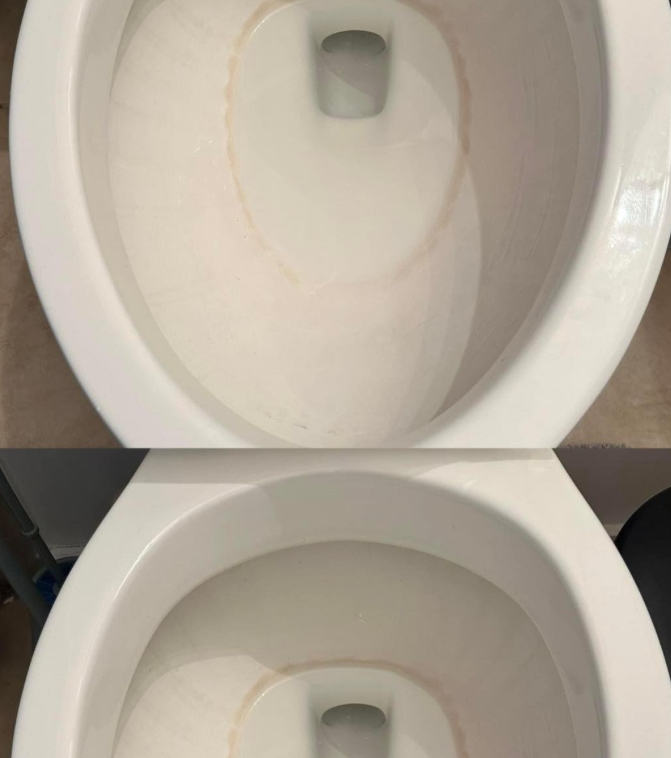How to Get Rid of Tough Stains in a Toilet: An Effective Guide
Cleaning the toilet may not be a glamorous task, but it’s essential for maintaining a hygienic bathroom. Hard water, mineral buildup, rust, and other residues can lead to stubborn stains that are hard to remove with regular scrubbing. If you’re struggling with tough toilet stains, this guide will help you get your toilet looking sparkling clean.
Why Do Toilet Stains Form?
Toilet stains are often the result of minerals in hard water, mold and mildew growth, or even rust from old pipes. These stains can build up over time and become difficult to remove without the right cleaning methods. Common types of toilet stains include:
- Mineral Deposits: Calcium, lime, and other minerals in hard water can leave white or grayish stains.
- Rust Stains: Iron in the water or from old pipes can cause reddish-brown streaks.
- Organic Stains: Waste and mildew can cause yellow or brownish discoloration.
Materials You’ll Need
Before you begin, gather the following materials:
- Rubber gloves
- Toilet brush or pumice stone
- White vinegar
- Baking soda
- Borax (optional)
- Lemon juice (optional)
- Commercial toilet cleaner (optional)
- A spray bottle for vinegar or lemon juice
Step-by-Step Guide to Removing Tough Toilet Stains
1. Flush the Toilet
Start by flushing the toilet to remove as much water as possible from the bowl. This will help your cleaning agents work directly on the stains. You can turn off the water supply and flush again if you need to lower the water level further.
2. Apply Vinegar
Pour about a cup of white vinegar into the toilet bowl, focusing on areas with visible stains. Vinegar’s acidity can help break down mineral deposits and organic stains. Let it sit for at least 10 minutes.
3. Add Baking Soda
After the vinegar has sat, sprinkle about half a cup of baking soda into the bowl. The reaction between the vinegar and baking soda will fizz, which helps to lift away grime and deposits.
4. Scrub with a Toilet Brush
Use a toilet brush to scrub the interior of the bowl, focusing on stained areas. For tougher stains, let the vinegar and baking soda mixture sit for 30 minutes to an hour before scrubbing.
5. Use a Pumice Stone for Tough Spots
If stains persist, use a pumice stone specifically designed for cleaning toilets. Wet the stone before scrubbing to avoid scratching the porcelain. Gently rub the stains in a circular motion. Pumice is highly effective for hard water and mineral buildup.
6. Try Lemon Juice and Borax (Optional)
For an extra boost, mix lemon juice with borax to create a paste. Apply it to the stains and let it sit for about 20 minutes before scrubbing. The acidity of the lemon and the abrasive quality of the borax work together to break down the stain.
7. Flush Again
After scrubbing, flush the toilet to rinse away the cleaning agents and loosened grime.
8. Use a Commercial Cleaner for Persistent Stains (Optional)
If stains are still present, you may consider using a commercial toilet cleaner specifically designed to tackle hard water and rust stains. Follow the instructions on the label carefully.
Preventing Future Stains
To keep your toilet clean and prevent future buildup, follow these tips:
- Regular Cleaning: Clean your toilet weekly to prevent mineral buildup.
- Use a Toilet Cleaner Tablet: Drop-in tablets can help keep the water clean and reduce the occurrence of stains.
- Install a Water Softener: If you have hard water, consider installing a water softener to minimize mineral deposits.
- Flush Regularly: Make sure to flush frequently, especially if you’re in a household with multiple people using the bathroom.
Common Mistakes to Avoid
- Using Abrasive Brushes or Tools:Avoid using steel wool or hard brushes that can scratch the porcelain. Stick to a toilet brush or pumice stone.
- Mixing Chemicals: Never mix bleach with vinegar or other acidic cleaners, as this can create harmful fumes.
- Neglecting to Clean Regularly:Waiting too long to clean can make stains harder to remove.
Natural vs. Chemical Cleaners: Which is Better?
Both natural and chemical cleaners can be effective, but natural solutions like vinegar and baking soda are safer for the environment and less likely to damage your toilet. Chemical cleaners are stronger and can remove the toughest stains more quickly, but they may come with harsh fumes and potential health risks.
Conclusion
Tough toilet stains don’t have to be a permanent problem. With the right approach, you can restore your toilet to its original brightness. Regular cleaning, preventative measures, and the use of natural or commercial cleaning products can make a huge difference in keeping your bathroom pristine. Follow these steps, and you’ll never have to worry about stubborn toilet stains again!
